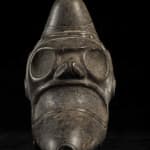Taino Stone Trigonolitos Depicting a Skull, 1200 CE - 1500 CE
Stone
10 x 7.5
LO.1317
Taino culture flourished in the Caribbean between c.1200-1500. The arrival of the Spanish in 1492 resulted in its rapid decline but objects such as this striking trigonolitos, also known as...
Taino culture flourished in the Caribbean between c.1200-1500. The arrival of the Spanish in 1492 resulted in its rapid decline but objects such as this striking trigonolitos, also known as a three-pointer, testify to high levels of craftsmanship. The Taino left no written language so our knowledge about them derives solely from archaeology and the testimonials of the Spanish settlers. As a result, although significant numbers of three-pointers survive, their precise function within Taino society is unclear. The central cone of these triangular objects has been interpreted in a variety of ways. Suggestions include manioc shoots (one of the main crops of the Taino), volcanoes, the roofs of Taino houses, phalluses and the human breast. None of these theories has been universally accepted and the precise origins of the shape are likely to remain a mystery. Despite this many scholars agree that these ceremonial objects were symbols of power and fertility. This seems to be supported by a letter written by Columbus in which he reports on his findings among the Taino, ‘Equally the majority of caciques (chiefs) have three stones to which they and their people have great devotion. One they say is for the fertility of the grain and vegetables that they grow; the next for mothers to give birth without pain, and the third for the water and sun when they have need.’
Three-pointers were made in various sizes and have a long history that predates the Taino fluorescence. Small examples with minimal decoration have been dated to c.400-200 BC. However anthropomorphic examples such as this one, with intricate incised decoration, played a crucial part in Taino public life. As Columbus’ testimony implies they were the preserve of the ruling elite and their ownership was synonymous with power.
One end of this piece has been carved in the form of a skull with large eye sockets and a broad jaw. The reverse has been incised with an abstract geometric design, including symmetrically arranged concentric circles. Symmetry is a recurring feature in Taino art and may have had religious significance. The Taino believed in the existence of a supreme god or creator called Yucahu Maorocoti and a fertility goddess called Attabeira. Ancestor worship was also fundamental to their belief system. Images of the gods and spirits were created in wood, bone, shell and stone and are referred to collectively as zemis. This example clearly had spiritual associations for its first owner and our inability to define them closely only contributes to its sense of mystery.
Three-pointers were made in various sizes and have a long history that predates the Taino fluorescence. Small examples with minimal decoration have been dated to c.400-200 BC. However anthropomorphic examples such as this one, with intricate incised decoration, played a crucial part in Taino public life. As Columbus’ testimony implies they were the preserve of the ruling elite and their ownership was synonymous with power.
One end of this piece has been carved in the form of a skull with large eye sockets and a broad jaw. The reverse has been incised with an abstract geometric design, including symmetrically arranged concentric circles. Symmetry is a recurring feature in Taino art and may have had religious significance. The Taino believed in the existence of a supreme god or creator called Yucahu Maorocoti and a fertility goddess called Attabeira. Ancestor worship was also fundamental to their belief system. Images of the gods and spirits were created in wood, bone, shell and stone and are referred to collectively as zemis. This example clearly had spiritual associations for its first owner and our inability to define them closely only contributes to its sense of mystery.



